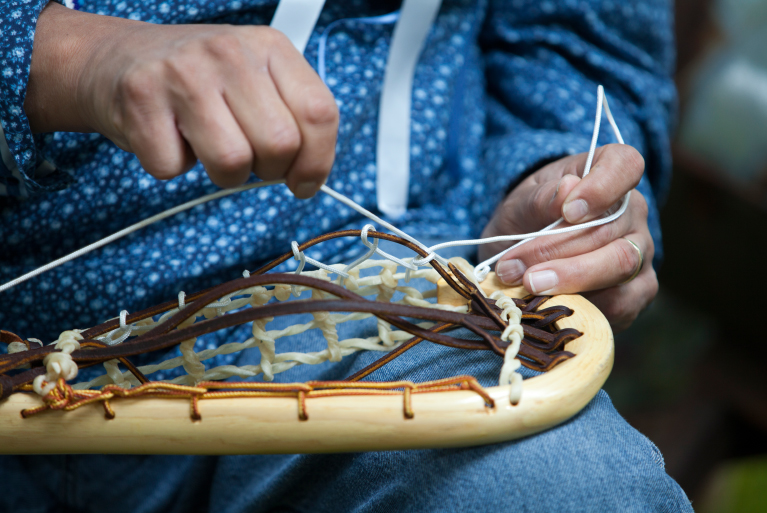By Clint Hill, Oneida Indian Nation Turtle Clan Council Member
May, 2001
Lacrosse – a spiritual game played centuries ago for recreation or political reasons – is a thriving sport throughout the world. For the Haudenosaunee, the people of the Iroquois Confederacy, lacrosse still inspires cultural passion and community healing. The game we feel was the Creator’s gift to his people remains a source of pride for those who play the game today.
Long before French settlers attempted to “civilize” the version they saw at Mohawk territories Akwesasne and Kahnawake with penalties, sidelines and goaltenders, lacrosse games had virtually no limits. Rough and boundless games, described as “bumping hips” by its players, involved many men from around the Six Nations and might have lasted for days.
Although the game was violent by nature, the purpose of the game wasn’t to hurt each other. Sometimes the game was played simply to please the Creator. Strength and stamina were important, making the game perfect physical conditioning for war. In fact, the game was sometimes called the “Little Brother of War” by some because it was often played to settle disputes between nations or villages.
That it helped keep the peace among the Six Nations was one of the reasons people described it as a medicine game. The social component was another. After games, after disputes were settled, the people would gather for a feast. Games kept the people and their nations close-knit, thus strengthening the confederacy.
Lacrosse purists delight in the wide-open version of today’s field game. With its speed and emphasis on passing, it’s a sport true to its roots. It is, however, a gentleman’s game adopted by elite private schools and colleges in the Northeast. This fact is made abundantly clear these days as Syracuse University seeks to add to its NCAA national title count.
For various reasons in the early 1900s, Indian teams and players were eliminated from amateur lacrosse exhibitions and the game became largely non-native. The traditional wooden stick of the Iroquois, handmade and each one unique, all but disappeared from the playing field with the introduction of the plastic and aluminum stick.
The spread of lacrosse throughout these Northeastern institutions laid the foundation for today’s hotbed. Generations of talented lacrosse players have sprung from the fertile playing fields of this region to continue the legacy their Iroquois neighbors began. The rosters of local Division I programs like Syracuse University, Colgate, Cornell and Hobart College list dozens of players from throughout Central New York, indicating homegrown talent.
And those Haudenosaunee neighbors? Determined to play the game they loved, Indian players turned to box lacrosse more than half a century ago and made it their game. A new summer pastime was born.
Developed in Canada to make use of ice rinks in the summertime, the game was a tighter, quicker version of its elder brother. With a greater emphasis on end-to-end play, the fearsome crosscheck became a staple for defensive players. The use of a wood stick for those jarring hits forced players to be more imaginative on offense. These factors attracted spectators eager to see natives playing lacrosse again.
The combination of fast-paced action and outstanding talent made box lacrosse, like the traditional field game, an important social component of Haudenosaunee culture. This region’s main box organizations, the northern Iroquois Lacrosse Association and the western Can-Am League, gave players and their families the opportunity to travel around Central New York and the Six Nations, keeping communities and their people close-knit.
An important point in the game’s modern history occurred when the Iroquois Nationals were welcomed into the International Lacrosse Federation as a nation, complete with its own flag and passports. The field team, comprised entirely of Haudenosaunee players, began competed in the 1990 World Games alongside countries like Canada, Japan, Australia and the United States. Established to develop positive role models and raise self-esteem for Haudenosaunee youth, the team also represents the sovereignty of the confederacy.
Lacrosse has become the lifeblood of this area, just as it has been for the Haudenosaunee people for centuries. Competition or recreation, the game fosters cultural understanding. The tradition of lacrosse exposes players to different cultures, helping to destroy stereotypes through respect and social interaction. For that we should remember to give thanks to the Creator for this great game.






